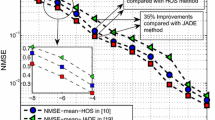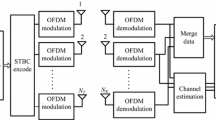Abstract
In this paper, a low-complexity modulation classification algorithm is proposed for the multiple-input multiple-output orthogonal space–time block code (MIMO–OSTBC) system. First, MIMO–OSTBC system is decoupled into several single-input single- output (SISO) systems by utilizing the orthogonal property of OSTBC. Then, these SISO systems are grouped into several two-input two- output systems. Finally, a maximum likelihood- based approach is used to classify the modulation. Both the cases of perfect and unknown channel state information (CSI) are considered. Simulations show that the proposed algorithm exhibits significantly lower complexity than conventional algorithm in both cases. Meanwhile, it provides better performance than conventional algorithm in the case of unknown CSI.



Similar content being viewed by others
References
V. Choqueuse, S. Azou, K. Yao et al., Blind modulation recognition for MIMO systems. MTA Rev. 19(2), 183–196 (2009)
V. Choqueuse, A. Mansour, G. Burel et al., Blind channel estimation for STBC systems using higher-order statistics. IEEE Trans. Wirel. Commun. 10(2), 495–505 (2011)
K. Hassan, I. Dayoub, W. Hamouda et al., Blind digital modulation identification for spatially-correlated MIMO systems. IEEE Trans. Wirel. Commun. 11(2), 683–693 (2012)
S. Kharbech, I. Dayoub, M. Zwingelstein-Colin et al., On classifiers for blind feature-based automatic modulation classification over MIMO channels. IET Commun. 10(7), 790–795 (2016)
E.G. Larsson, P. Stoica, Space–Time Block Coding for Wireless Communications (Cambridge University Press, New York, 2008)
M. Luo, L. Li, G. Qian, J. Lu, A blind modulation identification algorithm for STBC systems using multidimensional ICA. Concurr. Comput. Pract. Exp. 26(8), 1490–1505 (2014)
M. Marey, O.A. Dobre, Blind modulation classification algorithm for single and multiple-antenna systems over frequency-selective channels. IEEE Signal Process. 21(9), 1098–1102 (2014)
M. Moeneclaey, G. De Jonghe, ML-oriented NDA carrier synchronization for general rotationally symmetric signal constellations. IEEE Trans. Commun. 42(8), 2531–2533 (1994)
M. Muhlhaus, M. Oner, O.A. Dobre et al., A low complexity modulation classification algorithm for MIMO systems. IEEE Commun. Lett. 17(10), 1881–1884 (2013)
G. Qian, L. Li, M. Luo, On the blind channel identifiability of MIMO–STBC systems using noncircular complex FastICA algorithm. Circuits, Syst. Signal Process. 33(6), 1859–1881 (2014)
S. Shahbazpanahi, A.B. Gershman, J.H. Manton, Closed-form blind MIMO channel estimation for orthogonal space–time block codes. IEEE Trans. Signal Process. 53(12), 4506–4517 (2005)
Acknowledgments
The work and the contribution were supported by the Fundamental Research Funds for the Central Universities (Grants XDJK2016C138 and SWU116013).
Author information
Authors and Affiliations
Corresponding author
Appendix: The Proof for the Insensitivity of LF
Appendix: The Proof for the Insensitivity of LF
Based on (15), we can obtain
Then,
Therefore,
where \(\left\| {{\hat{\mathbf{h}}}} \right\| =\left\| \mathbf{h} \right\| =\sqrt{\hbox {tr}\left\{ {{\left[ {E\left( {\mathbf{YY}^{\mathrm{H}}-l\sigma ^{2}{} \mathbf{I}_{n_r } } \right) } \right] }/n} \right\} }\).
Next, we will prove that
Proof
Due to \(\begin{array}{l} \sum _{v=1}^{N_b } {\log \left\{ {\Lambda \left[ {{\tilde{\mathbf{y}}}(v)|\Theta , \mathbf{H}} \right] } \right\} } \\ =\sum _{v=1}^{N_b } {\log \left\{ {\Lambda \left[ {\left[ {{\begin{array}{c@{\quad }c} \mathbf{P}&{} \mathbf{P} \\ \mathbf{P}&{} \mathbf{P} \\ \end{array} }} \right] {\tilde{\mathbf{y}}}(v)|\Theta , \mathbf{H}} \right] } \right\} } \\ \end{array}\), the ambiguity resulted from \(\mathbf{P}\) can be neglected.
Moreover,
Then, (23) is proved. \(\square \)
Rights and permissions
About this article
Cite this article
Qian, G., Wei, P., Ruan, Z. et al. A Low-Complexity Modulation Classification Algorithm for MIMO–OSTBC System. Circuits Syst Signal Process 36, 2622–2634 (2017). https://doi.org/10.1007/s00034-016-0428-y
Received:
Revised:
Accepted:
Published:
Issue Date:
DOI: https://doi.org/10.1007/s00034-016-0428-y




